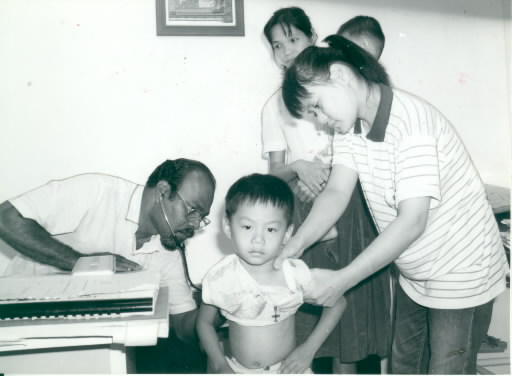6. Doing His Utmost to Serve the People
Feb. 27, 2013
Chapter 4: India, Malaysia, Korea
Part 2: Thorium Contamination in Malaysia
Part 2: Thorium Contamination in Malaysia
In the center of Bukit Merah stands a converted Chinese-style house, and outside it a sign saying Klinik Desa (Rural Clinic). On a nearby wall are two carved wooden signs in Chinese which Dr. Thambyappa Jayabalan received from grateful residents of the village. One says "Dispensing Care with Kindness and Sympathy" and the other "Doing his Utmost to Serve the People."
"I consider it a great honor," he said, his eyes crinkling into a smile behind his glasses. An examination table, some basic medical equipment, various drugs, and a box of medical files were crammed into a space about twelve feet square. "It's not really enough," he continued, looking round the room. "But we manage somehow."
After working at Ipoh General Hospital, Dr. Jayabalan opened his own practice in Kuala Lumpur in 1983, then moved to Bukit Merah in January 1987. He is the first resident doctor the village has ever had. His wife and two children remain in Madras for the sake of the children's education. "Why did I come here? Professional curiosity, I suppose. I wanted to know what sorts of effects low doses of radiation have on the human body; it was a whole new field for me."
Dr. Jayabalan's speciality is pediatrics, and in addition to his everyday work, he made a comparison of the white blood cell counts of 260 children in Bukit Merah with those of 191 children on Carey Island, Selangor.
"I chose Carey Island because of the similarity of the environment to here; the reason I chose to investigate the single-nucleus white blood cell count was because I'd read that a decrease was noted among people exposed to radiation in the Marshall Islands. I thought there might be a similar result because exposure to radiation was common in both cases." Single-nucleus white blood cells are one of the most important elements of the body's immune system and the body becomes more susceptible to disease if they are damaged in any way.
Dr. Jayabalan was surprised at the results he received from the hematology research center in Kuala Lumpur. While the children of Carey Island showed no abnormalities, half of the children surveyed in Bukit Merah had white blood cell counts of fewer than two hundred. The usual figure is between two hundred and eight hundred.
"All the island children showed normal counts, but five children here had very low counts. I think this result can be put down to radiation." Dr. Jayabalan also conducted a survey on miscarriages in Bukit Merah. He studied 108 women who had become pregnant between 1982 and 1987, excluding those over the age of thirty and those who had had abortions. Seven miscarriages in two hundred pregnancies were noted.
"On average there were forty pregnancies each year. In 1982 and 1986 there were two miscarriages, a rate of 5%. This is three times the national average of 1.8% and higher than the rate in other years."
The doctor felt a sense of foreboding about these figures, which was heightened by the sudden appearance of three cases of leukemia, the death of a young employee of ARE from meningitis, and the discovery of a malignant tumor in a five-year-old boy.
Dr. Jayabalan is an Indian Malaysian, but most of his patients are of Chinese origin. He treats the poor for no fee. During the day a young woman is employed part time as a receptionist; in the evenings, adults work at the clinic on a voluntary basis. Between consultations the doctor works on his own research. "It's a twenty-four-hour job here. I'm always on the verge of bankruptcy, but the locals rely on me, so I can't let them down." In cooperation with the village people the doctor has established a medical fund to help those in need of major operations. He also expressed the hope that one day he will be able to build a proper hospital, with proper equipment.








